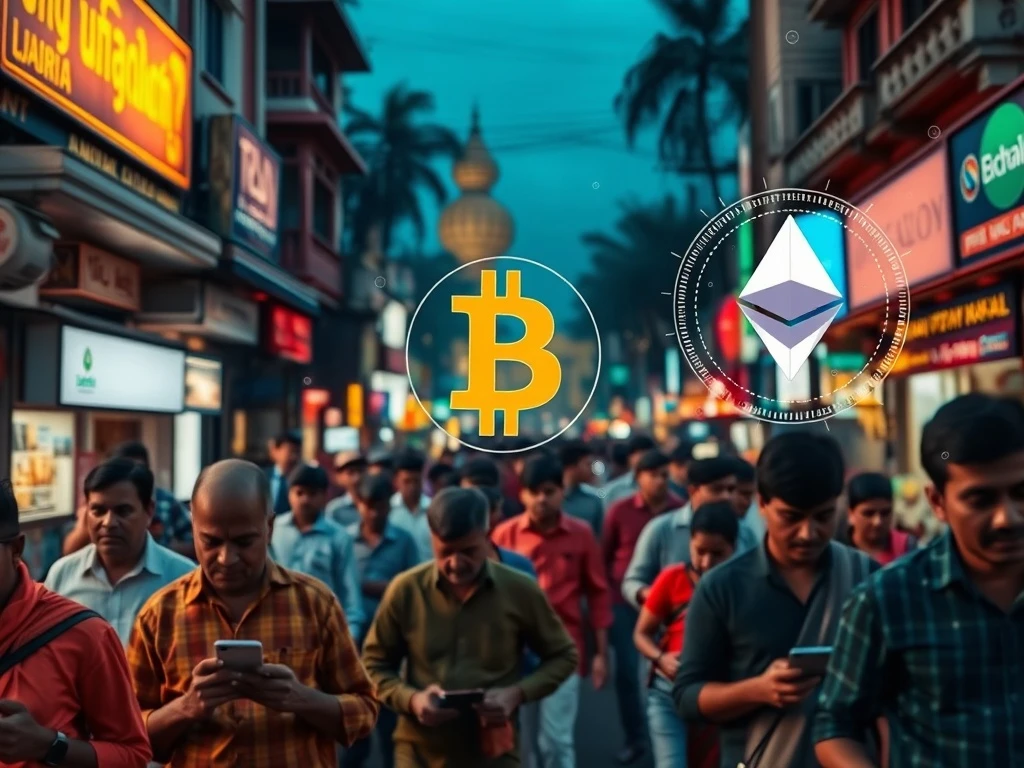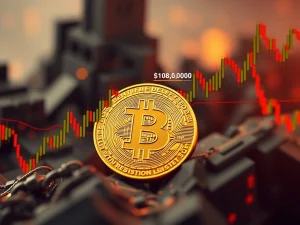India Crypto Policy: Unstoppable Demand Builds Momentum for Change

Despite navigating a complex and often restrictive regulatory environment, a powerful movement is gaining traction within the **Indian Crypto Market**. Millions of users are embracing digital assets with remarkable enthusiasm, creating a compelling case for a fundamental shift in the nation’s **India Crypto Policy**. Could this burgeoning demand finally compel the government to rethink its approach to cryptocurrencies?
Understanding India Crypto Policy’s Current Stance
India’s relationship with cryptocurrencies has been characterized by caution and a lack of clear, comprehensive regulations. While not outright banned, the current **India Crypto Policy** framework is ambiguous, leading to uncertainty for both investors and businesses. This regulatory vacuum is coupled with a taxation regime that many crypto proponents argue is stifling innovation and growth within the sector.
As Sujal Jethwani, a prominent crypto educator, aptly describes it, the current Indian crypto landscape resembles a ‘suppressed spring.’ Despite the restrictive rules and heavy taxes, the underlying demand for digital assets continues to build pressure. The government’s approach has been to manage crypto through fiscal measures rather than a dedicated regulatory framework. This includes significant tax burdens that have become a major point of contention for the burgeoning crypto community.
The Unyielding Crypto Demand India is Witnessing
Even with the existing hurdles, the **Crypto Adoption India** narrative is one of impressive growth. Jethwani highlights a noticeable trend: traditional stock market and forex traders are increasingly migrating to cryptocurrencies. This surge in interest is not just from new entrants but also from experienced investors seeking new opportunities in the digital asset space. The allure of crypto, with its potential for higher returns and global accessibility, proves strong enough to overcome the regulatory uncertainties.
This escalating **Crypto Demand India** is a critical factor in the ongoing debate. When millions of citizens actively participate in a market, their collective actions inherently exert pressure on policymakers. The sheer volume of transactions and investments indicates a deep-seated interest that cannot be easily ignored or wished away. People are not simply dabbling; they are committing to crypto, viewing it as a viable investment avenue and a part of the future financial landscape.
How Indian Crypto Tax Laws Impact Adoption
The **Indian Crypto Tax** framework is a primary source of frustration for the crypto community. Currently, profits from selling Virtual Digital Assets (VDAs) are subject to a flat 30% tax rate. This high rate is often criticized for being punitive, treating crypto gains differently from other asset classes that might enjoy more favorable capital gains structures. Beyond the profit tax, a 1% Tax Deducted at Source (TDS) applies to all crypto transactions exceeding a relatively low threshold of $115. This TDS is deducted from either the seller or the buyer, adding a layer of complexity and perceived burden to every trade.
The 1% TDS, in particular, has been singled out by crypto proponents as a major deterrent to trading activity. It increases the cost of frequent trading and can significantly reduce liquidity in the market. While intended to track transactions and ensure tax compliance, its implementation has, paradoxically, led to some trading volume shifting to international exchanges or peer-to-peer channels, making it harder for the government to monitor. This illustrates a clear challenge in the current **Indian Crypto Tax** approach: rather than fostering a compliant domestic market, it risks pushing activity underground or offshore.
The Rising Voice for Bitcoin India and Regulatory Clarity
Amidst the growing user base and tax debates, there’s a discernible shift in the political discourse. A significant development was the recent call by Pradeep Bhandari, the national spokesperson for India’s ruling party, for the country to explore launching its own Bitcoin reserve. This proposal, drawing parallels with similar discussions in the United States, signals a growing political awareness of crypto’s strategic importance. Bhandari also emphasized the need for clear regulatory guidelines and suggested India is well-positioned to develop a sovereign **Bitcoin India** strategy.
This kind of public statement from a political figure represents a notable departure from previous, more uniformly cautious stances. It indicates that the potential benefits and strategic implications of digital assets, particularly Bitcoin, are beginning to penetrate higher levels of government. The idea of a **Bitcoin India** reserve could position the country as a forward-thinking player in the global digital economy, potentially offering a hedge against traditional economic volatility and diversifying national reserves.
Navigating the Future of the Indian Crypto Market
While the momentum for change is building, the pace of reform in the **Indian Crypto Market** may be deliberate. India has a history of slow, measured adoption of new technologies, often taking a cautious approach before fully embracing disruptive innovations. However, as Jethwani asserts, the sheer volume and persistence of crypto users will ultimately ‘force’ the government’s hand. This isn’t about outright defiance but about the undeniable economic reality and the widespread public interest.
The collective action of millions of **Indian Crypto Users** – through continued adoption, engagement with policymakers, and the sheer economic weight of their activities – creates an irresistible force. The government will eventually have to seriously consider more favorable rules and a clearer regulatory framework that balances innovation with consumer protection and financial stability. This evolution is not a question of ‘if’ but ‘when’. The future of the **Indian Crypto Market** hinges on this dynamic interplay between user demand and governmental response, promising a fascinating period ahead for digital asset enthusiasts globally.
The Inevitable Shift: What’s Next for India’s Crypto Journey?
The narrative unfolding in India is a microcosm of the global crypto adoption story: a clash between established regulatory frameworks and the decentralized, borderless nature of digital assets. The ‘suppressed spring’ of **Crypto Adoption India** is building immense pressure, driven by a growing, tech-savvy population eager to participate in the digital economy. The current **Indian Crypto Tax** policies, while designed to manage risk, are inadvertently fueling the demand for clearer, more progressive regulations.
From calls for a **Bitcoin India** reserve to the grassroots movement of millions of users, the signs are clear: the **Indian Crypto Market** is too significant to be ignored. While the path to comprehensive and favorable regulation may be gradual, the unwavering demand from its citizens creates an undeniable impetus for change. The eventual policy shift will not just benefit Indian crypto users but will also send a powerful signal to the global financial community about India’s embrace of the digital future. This journey of transformation, driven by the people, promises a vibrant and regulated crypto landscape for one of the world’s largest democracies.








